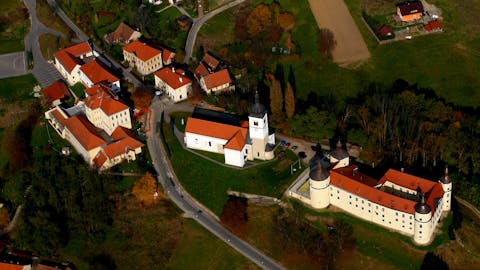
Ormož Municipality
Velika Nedelja – Castle and Church of St. Trojica
The exact time of the construction of the Romanesque parish church of the Holy Trinity, with its eastern tower and semicircular apse, is not entirely clear. The most likely theory is that the earliest building history of the church in Velika Nedelja can be divided into two phases: the older Romanesque phase with two sub-phases—the last third of the 12th century, when the present barrel-vaulted bell tower and apse were built, and the beginning of the 13th century, when Frederik III of Ptuj transformed it into a church by adding the nave—and the younger early Gothic phase around 1280, with the construction of the first floor of the bell tower and the enlargement of the nave. In the late Gothic and Renaissance periods, the now-walled apse windows were twice remodeled, and a sacristy was added to the north wall of the bell tower, partly extending into the nave. Between 1674 and 1698, the nave was lengthened, raised, and vaulted a second time, a choir loft with a richly stuccoed front wall (the work of J. Schomassi) was added to the extension, the tower was raised, a northern chapel was built, and entrance vestibules were added to the western and southern nave entrances. At that time, the church received a western façade articulated with pilasters and semicircular niches, marked by a console with the year 1698 and the cross-bearing coat of arms above the simple entrance porch. In the first half of the 18th century, the nave walls were raised slightly, the southern vestibule was replaced by a chapel, the sacristy was extended with an oratory, and the entire church was encircled with a richly profiled cornice. Around the mid-18th century, both chapels were decorated with stucco, especially their triumphal walls. In the second half of the 18th century, most of the high-quality Baroque furnishings were added. The high altar, created around 1770, is the work of the Maribor sculptor Jožef Holzinger. The chapel altars, with paintings of St. Jožef and St. Janez Nepomuk, are similar but not identical works dating from 1762, while both paintings are by the same, as yet unknown, artist. Particularly noteworthy are the pulpit and the Crucifixion altar, which show similarities with the workshop of J. J. Mersi in Rogatec. Around 1770, with the closing of the triumphal arch, the eastern part of the church was transformed into the Chapel of the Devica Marija, with a high-quality altar of St. Jožef, dated 1760, originally from a house chapel at Goričak near Zavrč. The church is also significant for several preserved pieces of Romanesque architectural sculpture, of which very few remain in Slovenia. In addition to two facial reliefs (a head above the apse roof and the relief of a man’s face now built into a niche in the southwestern part of the nave, originally set in a rectangular recess high in the church wall), there is also a knee-length sculpture of a bearded man, which a few decades ago was still built into the south side of the bell tower but is now kept in the Ptuj–Ormož Regional Museum, and above all the Romanesque baptismal font in the church apse. This is the only Romanesque baptismal font in Slovenia, most likely dating from the second quarter of the 13th century. The church is further distinguished by its medieval frescoes, preserved on the north and south nave walls. On the north wall, the paintings are arranged in three horizontal bands; on the south wall, in two, reaching to the full original height of the flat-roofed nave. The lower bands on both walls are dedicated to standing saints with their attributes, while above them, on both sides, appear narrative saintly scenes. The so-called Master of Velika Nedelja at first glance shows an early stage of the so-called “soft style” around 1400, but in the types of heads, poses of the figures, and the drapery folds, one still senses memories of the 14th century. For this reason, the frescoes can be dated to the last decade of the 14th century. The same master also painted scenes from a saint’s legend on the north wall of the northern chapel of the Parish Church of St. Jakob in Ormož.